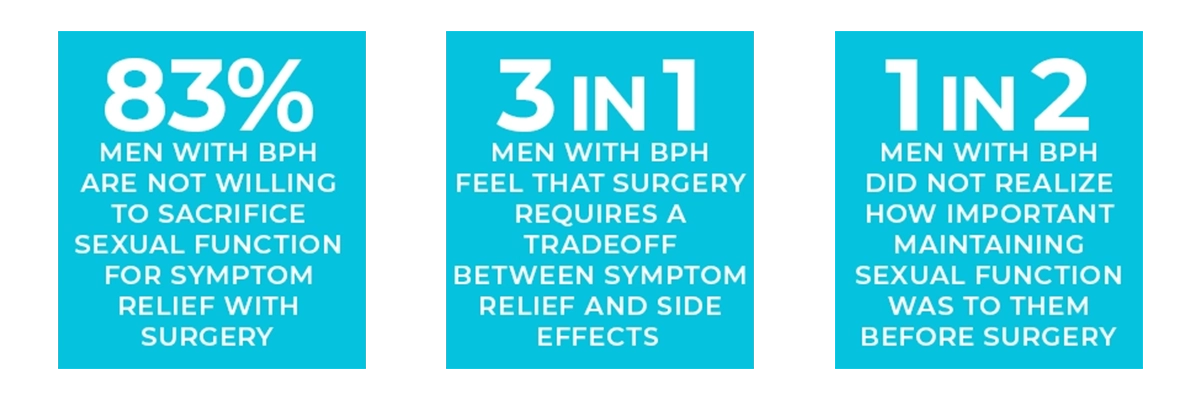Urology
Aquablation Therapy Surgical Treatment for BPH (enlarged prostate)

Lexington Clinic and Commonwealth Urology, A Part of Lexington Clinic, are proud to be among the first in the region to offer Aquablation therapy – a new, advanced, minimally invasive, surgical treatment for benign prostatic hyperplasia (BPH).
We know choosing a BPH treatment option can be overwhelming, as it often forces men to compromise in some way - not responding well to medication, experiencing limited relief, having a long recovery time or experiencing sexual function issues.
Aquablation therapy is a one-of-a-kind procedure that aims to minimize these compromises, helping men suffering from BPH to get their life back and feel like themselves again.

What is Aquablation Therapy?
Aquablation therapy uses the power of water delivered with robotic precision to provide long-lasting BPH relief without compromise. It is precise, consistent, and predictable and provides long-term relief no matter how large your prostate.
How Does Aquablation Therapy Work?
Aquablation therapy is a resective procedure, which means that the prostate tissue causing symptoms is surgically removed. No incision is made in the abdomen, as the prostate is reached through the urethra. The procedure is done under anesthesia in a hospital setting, typically taking less than an hour, and involves an overnight stay.
There are two key steps to the Aquablation procedure:
Step 1. Creating a Surgical Map
Every prostate is unique in size and shape. Aquablation therapy enables our surgeons to customize your procedure to your specific anatomy.
How?
Aquablation therapy is the only BPH surgical procedure integrates ultrasound imaging with the standard camera (called a cystoscope). This gives our surgeons the ability to see the entire prostate in real time, which allows our surgeons to map which parts of your prostate that need to be removed and which parts need to be avoided.
Specifically, this mapping enables our surgeons to avoid removing the parts of the prostate that cause irreversible complications like erectile dysfunction, ejaculatory dysfunction and incontinence.
Step 2. Removing the Prostate Tissue
Once our surgeons have created a surgical map, a robotically-controlled, heat-free waterjet removes the prostate tissue that was outlined on the map. This robotic technology minimizes human error in removing prostate tissue, and ensures the prostate tissue is removed precisely, consistently and predictably.
When required, our surgeons may choose to use a minimal amount of cautery following an Aquablation procedure to control bleeding.
What are the Side Effects of Aquablation Therapy?
We know that the primary reason men are delaying surgery is because they are concerned about side effects. In fact, a recent survey shows that 85% of men are concerned that surgery will cause incontinence and 4 out of 5 men are concerned that surgery will have a permanent impact on their sexual function.
In clinical studies, men who had Aquablation therapy had a very low rate of irreversible complications—incontinence, ejaculatory dysfunction, erectile dysfunction.
 Is Aquablation Therapy Right for You?
Is Aquablation Therapy Right for You?
Aquablation therapy is a different kind of surgical procedure. Make sure to discuss with our surgeons to see if you’re a candidate. There are three reasons it may be right for you:
- Low Rates of Irreversible Complications
Aquablation therapy has a very low rates of irreversible complications (incontinence, ejaculatory dysfunction, erectile dysfunction) - Confidence in Procedure
Aquablation therapy removes prostate tissue with a robotically-controlled waterjet. This robotic technology minimizes human error and ensures the prostate tissue is removed precisely, consistently and predictably. - Long-Term Relief
Aquablation therapy has been shown to provide durable symptom relief.
Aquablation Recovery
As with most BPH procedures, you will wake up with a catheter. Patients typically stay overnight in the hospital. We may send you home with a catheter for a few days or may keep you an additional night in the hospital if you are unable to urinate on your own or empty your bladder at the time of discharge.
We know that no one likes staying overnight in a hospital. However, the benefit with Aquablation therapy is that most patients end up leaving the hospital without a catheter.
Once you are home, you may experience mild burning during urination for a couple of weeks. This can be managed with mild pain medication.
Your surgeon will discuss your recovery instructions with you and will answer any questions you may have.
For more information about Aquablation Therapy, call (859) 258-4361 or (859) 258-6450.
Learn about Ed's personal journey evaluating his concerns with BPH surgery and why he refused to trade off side-effects with quality of life.

